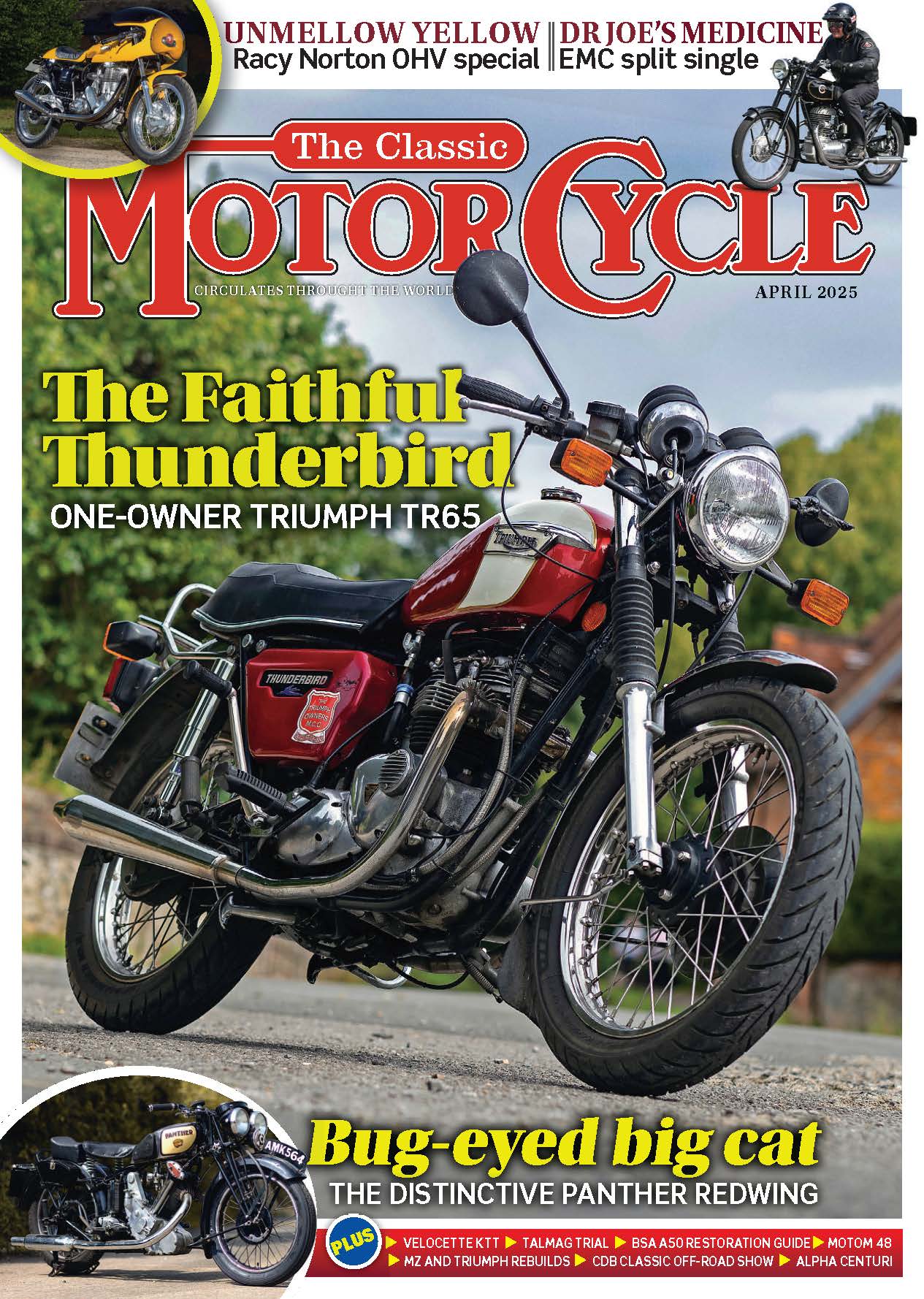Was the Sunbeam S7D just “a nice bit of engine stuck between two ring-doughnuts”? Well, a lot depends on the quality of the doughnuts!

Words: STEVE WILSON Photographs: GARY CHAPMAN
The Sunbeam S7D (for De Luxe) was described and defined as ‘The Gentleman’s Motorcycle’. And this one lived in a context which ticked all the boxes.
Enjoy more Classic MotorCycle reading in the monthly magazine.
Click here to subscribe & save.
In a venerable village at the base of the Downs, at the end of a drive hundreds of yards long, lies a very nice house in several well-tended, tree-fringed acres, surrounded by a multitude of barns and stables. In one of them there is a well-patinated soft-top Morris Minor.
Like the house, the Minor belongs to the Sunbeam owner’s partner, Tina, a game girl who when we first met at our local show, had just carried two folding chairs for several miles while riding on the S7’s pillion pad. The owner, David Tilton and his late wife had both grown up in Leicester and later they returned there. But after his wife had sadly passed away some years ago, David finally had moved south to be with Tina. “I’m not complaining,” he said, gesturing around.

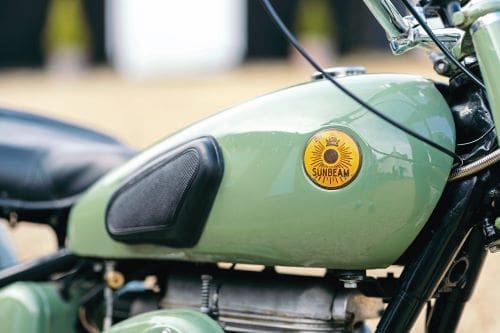
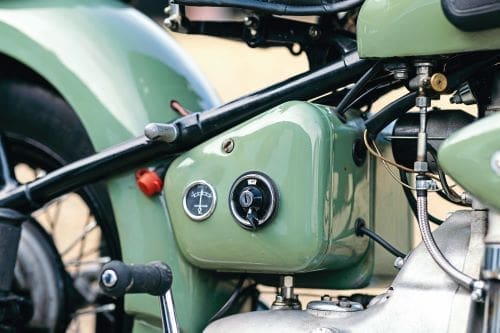
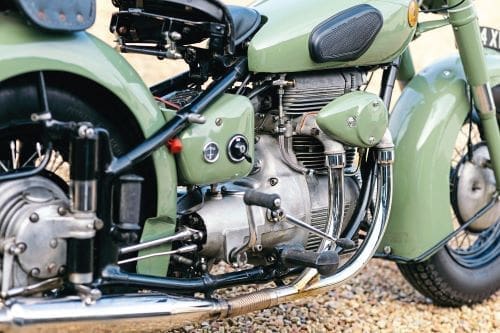
To the Manor Born
The Mist Green S7D with its elegantly curvaceous lines looked right at home on the gravel drive. David had bought it five years ago. It was a somewhat unusual choice, given his former profession; he had been a fighter pilot in the RAF, on the Tornado GR1, the ground attack version. So, an officer and a gentleman.
A previous British bike had been a 1960s BSA A65 Thunderbolt. “I like the Sunbeam’s quirkiness,” said David. “I’ve also got a Cyclemaster,” the 1950’s 30cc clip-on two-stroke. “A friend took me down to Pendine Sands when they were racing them! With the S7, I’ve probably only ever seen 50mph. I ride it into the market town now and then, to get the Sunday papers. Or up onto the Berkshire Downs with Tina, we take a drink, park up and watch the sunset…”
If that all sounds a bit sedate for a former skydiver, it should be said that David had just returned from the MC Piston rally in Spain on his other bike, a Suzuki GT750. I know the Picos de Europa mountains are lovely, but they can be a bit challenging after a long day’s ride; David witnessed one bike crash resulting in broken bones, and sadly, heard about another that had involved a fatality. This puts his local ‘potter-bus’ mode on the S7D into perspective – horses for courses.
We walked round the Sunbeam, David pointing out a charging point fitted to keep the battery topped up. The coil electrics are now 12-volt, as the S7D had been fitted with a replacement for its original front-mounted six-volt Lucas pancake dynamo, a 12-volt Lucas alternator. This had come from the post-Second World War Sunbeam spares suppliers, manufacturers and gurus, Stewart Engineering (Tel: 01202 768220) down in Poole, Dorset. They had also provided the aftermarket deeper sump pan fitted for the S7D’s car-type wet-sump lubrication system, which not only carries more than the standard four pints of oil, but also an additional full flow paper oil filter.
Checking the reconditioned speedometer, David mentioned that he thought that the S7D had been, and maybe still was, on sidecar gearing. Fetching a screwdriver, he removed the inspection cover on the shaft drive’s rear hub worm-gear housing, as from 1950 the serial numbers for either set of solo or sidecar worm and wheel drive had been stamped on the worm-wheel edge.
We failed to locate it, but that gave me an excuse to contact Andy Chapman at Foxwood Motorcycles R & R (Tel: 07855 948123) in Farnham, Hants. An Ariel singles and S7/S8 specialist, Andy had undertaken major work on David’s bike. It was Andy’s personal S8 we’d tested in TCM December 2019, and I had been impressed by the ex-aeronautical engineer’s steadiness and depth of knowledge. He did not disappoint now, providing several insights into the S7D’s nature.
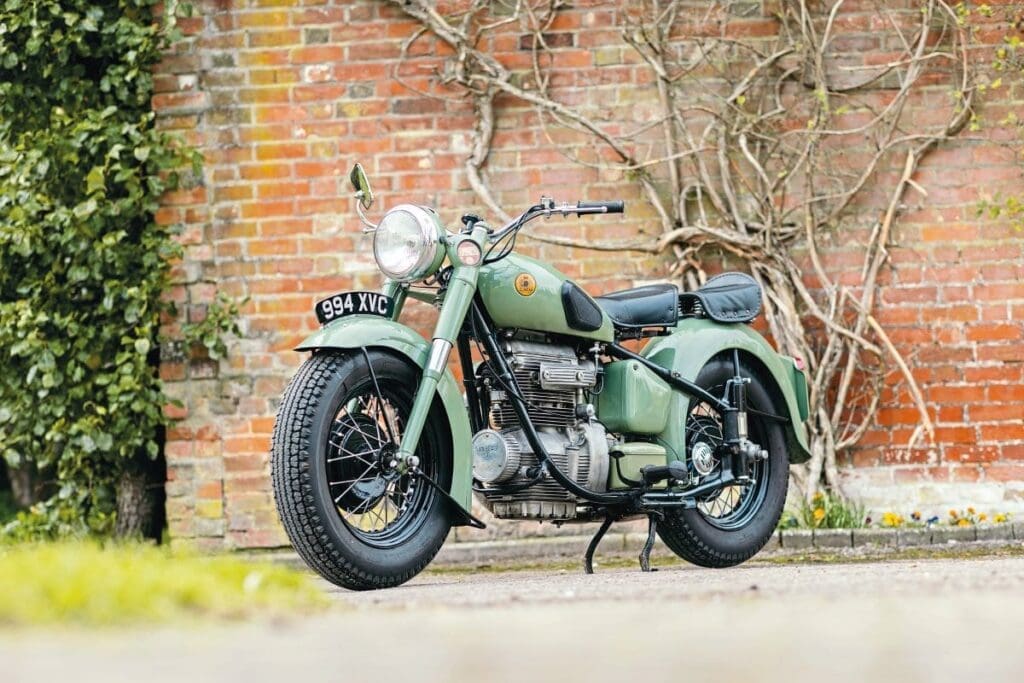
The Specialist
David had turned over the Sunbeam, which had been smoking badly, to Andy, for what turned out to be major work on the engine. It needed reboring for what Andy reckoned was the third time, to +0.030 (+0.040 is these Sunbeams’ limit), with new pistons fitted. The crank was reground, probably for the second time. New big end shells were fitted.
David brought the bike back to Foxwood in September 2021 as it was still smoking, oil consumption had been high, and the speedo was malfunctioning. While Andy works, he provides the customer with a typed-up, day-by-day log of what he is doing, and why. In this case, there was no smoke from the exhaust after a high-revving run, but there was unburnt oil in the exhaust and tailpipe.
With the head removed, the cylinders had been perfect, and there was no sign of oil rising up past the pistons; but there was a significant quantity of oil lying in the cylinders. There was no indication that it was being drawn in through the valve guides (rare, on these Sunbeams). But the copper head gasket showed some staining of its top surface, indicating oil/gas leakage, possibly because the head had been skimmed previously.
Andy dismantled the head, removing the camshaft. He found some damage to the roof of the front combustion chamber. He repaired a damaged thread on the right-hand front head stud; he pointed out that with the all-alloy engine/gearbox, threads are easily stripped, which tends to happen when home mechanics try to stop oil leaks by over-tightening. The standard engine breather in the oil pump housing was supplemented by another at the front of the cam-box, containing three small spring-loaded disc breathers. These are no more than adequate, if they are kept clean; but with Sunbeams running hot, crankcase pressure and subsequent oil leaks can be a problem.
After forcing solvent through the head’s feed passage, Andy skimmed the head joints’ surfaces, then rebuilt the head. He annealed and fitted a new, thicker, 1.6mm copper head gasket, to compensate for the skimming. But he warned of the possibility that, though the damage to the head could have been through corrosion, alternatively it might have been from a hairline crack or a porous head, both very hard to detect. Restoration work is full of these uncertainties, and a good engineer has to at least recognise the possibilities.
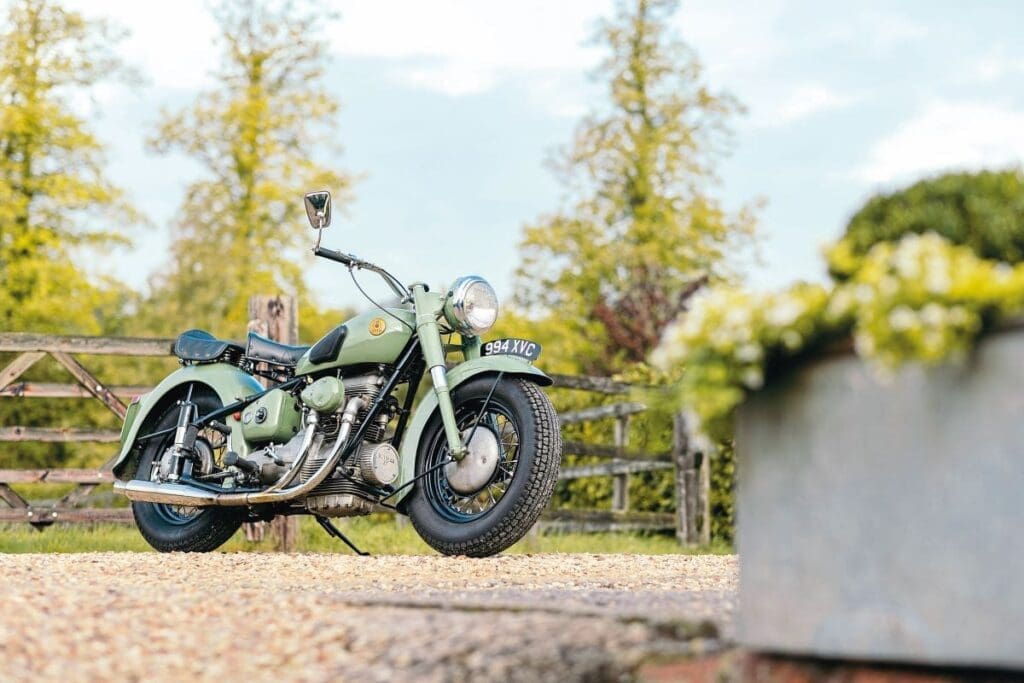
Reassembling, he noted that in the horizontally-mounted distributor to the rear of the cylinders, the distributor arm had been colliding with the condenser and had almost chewed through the condenser wire. He knew the cause was that condenser replacements by then had been larger than the originals. Andy had reshaped the rotor arm with linisher and file to eliminate the friction. But today the indispensable Stewart Engineering have had a fresh batch of condensers made up, to the original size.
Fuel had been leaking from the tank’s cap and causing paint damage; a new cap was fitted. Neither warning light was working; both bulb holders were incorrect, and the dynamo charge light was wrong now that the 12-volt alternator had been fitted, while the non-original oil pressure light holder had one terminal broken off. That was fixed, though a correct new green warning light bulb cost £43!
Next the rear end had to be completely dismantled, including the Lay-rub coupling for the shaft drive to the gearbox. This was so that the new parts ordered for the speedo drive could be fitted – Andy believed the ones in place had been for solo not sidecar gearing. After confirming that the rear worm and wheel set were for sidecar use, he fitted a new sidecar ratio drive worm for the speedo onto the rear of the gearbox layshaft. (The low-powered, relatively high-revving Sunbeam engine may not have seemed an ideal sidecar tug, but in the 1950s one in every three large capacity British motorcycles pulled a chair (as had the BMW R75), and the S7’s frame had been equipped to take one on either the left or the right side.)
Finally, Andy dismantled and adjusted the eight-inch rear brake’s shafts and springs which had been assembled in the wrong order, and put the cross-shaft components back as they should have been. A last test ride showed that the smoking had been cured, but that despite having lowered the needle one position, the mixture was a little weak, and hot-starting not perfect.
Andy thought the problem was probably that the 15/16th inch Amal 276 remote-float carb, a prewar design employed for the whole S7/S8 production run, was past its best. Stewarts can provide Concentric replacements – but Andy added that you had to be particularly careful not to overtighten them…
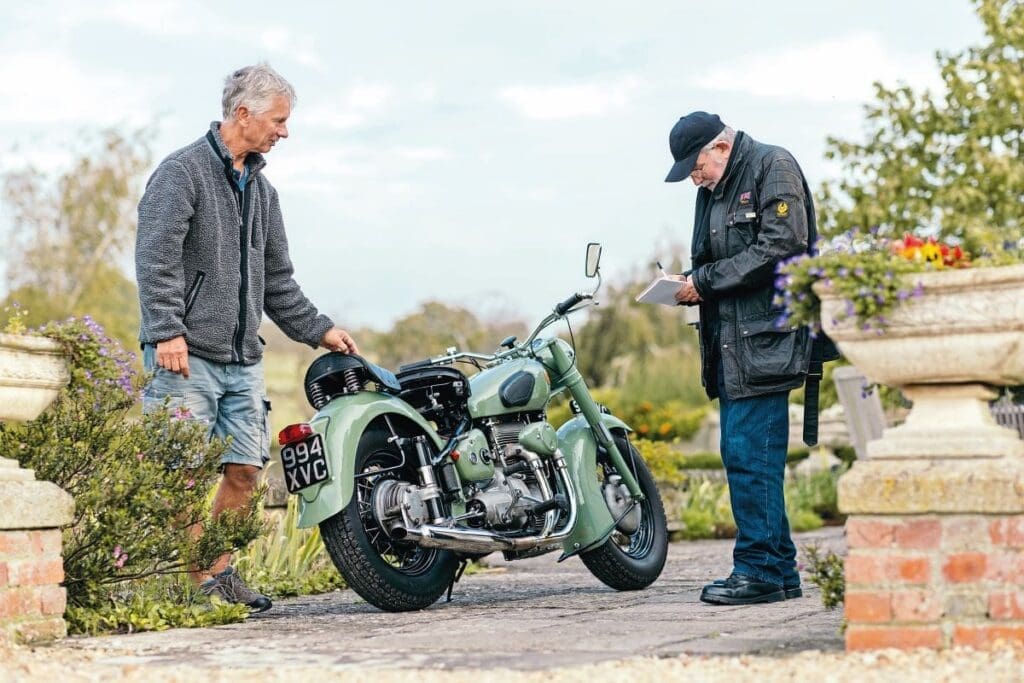
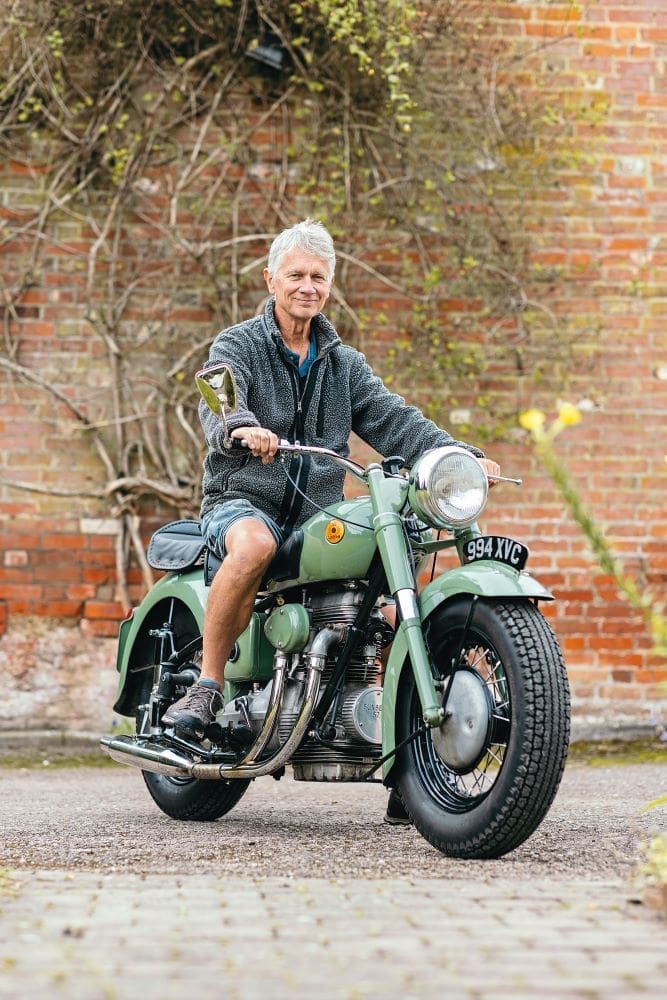
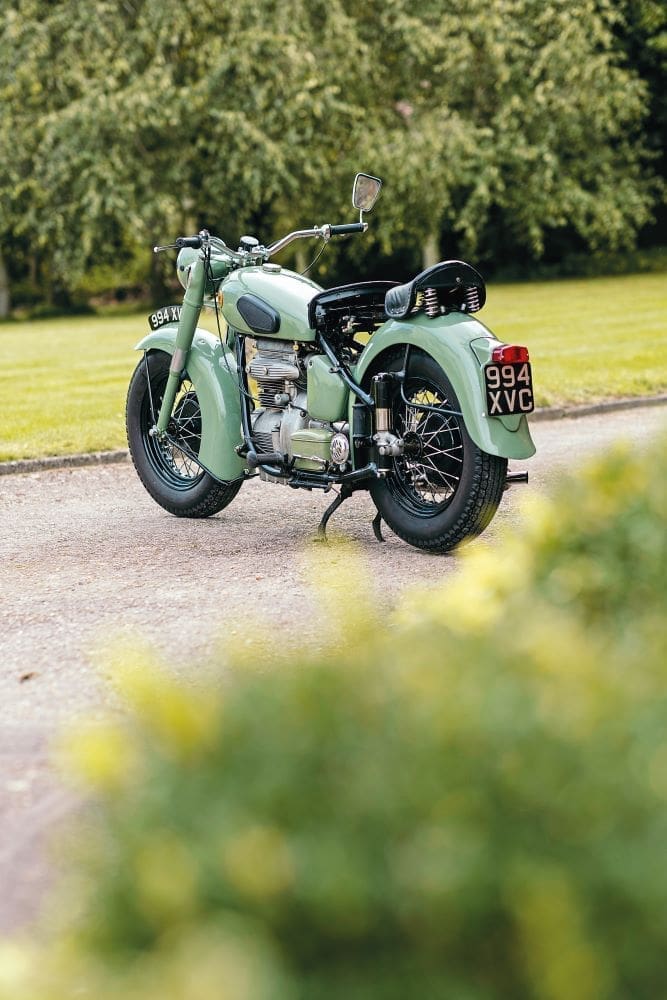
The S7 De Luxe Story
The BSA Group had bought the prestigious Sunbeam name off AMC in 1943, mainly for use on the Group’s bicycles, but also to distinguish a flagship luxury model for the postwar market.
The history of the early S7s, produced from mid-1947 to mid-1949, fruit of the car and motorcycle designer Erling Poppe, had been troubled. The S7 had been based loosely on examples of the BMW R75 captured in wartime, with the same brakes, tyres and big (initially interchangeable) wheels, front-mounted pancake dynamo, and shaft drive.
For the engine, since a flat-twin was deemed too discernibly German-originated for the Allied market postwar, Poppe, who had long aimed at designing a luxury motorcycle, may have looked sideways at the distinguished French Dresch in-line twin of the early 1930s. Poppe’s 487cc, all-alloy engine, oversquare at 70×63.5mm, with the gearbox bolted up in unit behind the cylinders, sensationally featured a chain-driven overhead camshaft.
However, requiring a ‘conventional’ kick-start on the right contributed to the abandoning of BMW’s proven crown wheel and bevel shaft drive system. The other factor in this had been the design requirement to fit the luxury of (plunger) rear suspension, rather than the R75’s rigid rear end. On Poppe’s engine, with the line on which the drive shaft had emerged, this had meant that on full upward suspension travel, the BMW drive could be damaged. So he had adopted an unsuitable bronze wheel and steel worm drive, possibly derived from BSA’s Lanchester car subsidiary’s steering worm drive.
The result, especially on Poppe’s original cross-flow, hemi-head, 90mph engine, was disastrous. The worm-drive’s oil turned gold as the bronze wheel wore away to unserviceability after just 5000 miles. In addition, severe shaft-drive torque combined with a poorly designed front fork to give bad handling; and vibration from the short stroke engine was so bad that a prototype batch of S7s, sent in December 1946 to escort the high-profile Royal tour of South Africa, were sent back as unrideable.
Rubber-mounting the engine front and rear, with snubbers against side movement, plus an extra frame tube across the front, were only partially effective. The engine had to be detuned, now with a smaller carburettor, plus a squish-type cylinder head and valve angles reduced from 45 to 22.5 degrees. Output was claimed to be an unsensational 25bhp@5800rpm (the actual figure was 23.5bhp), and top speed on test 75mph.
By mid-1947 when the S7 finally got into production, Poppe had been fired. But a reputation for poor reliability and overheating, a substantial weight at 435lb dry (Triumph’s 500cc Speed Twin was 70lb lighter), a high purchase price, and with petrol rationed, unimpressive consumption figures at around 50mpg (Triumph’s sporting T100 returned 70mpg overall, and the cooking 5T much more), combined to mean that from then until the S7D and S8 launch in mid-1949, only 2014 S7s had sold.
Meanwhile one of Small Heath’s top engineers, David Munro, prominent in the development of the Gold Star, had been on the case. He was assisted by R Harrison, the chief engineer at BSA’s Redditch factory where the Sunbeams were made, along with Bantam engines (though tensions between there and Small Heath later did for Harrison’s prototype 600cc Sunbeam version, as well as a four-cylinder one).
The S7 De Luxe’s oil sump had been increased to four pints. The crack-prone cylinder liners became a loose fit. A second scraper ring went on the alloy pistons, to counter oil collecting on the (non-detachable) cylinders’ walls. The rubber mountings were revised, the existing ones greatly enlarged and a friction damper-type head-steady added behind the cylinders.
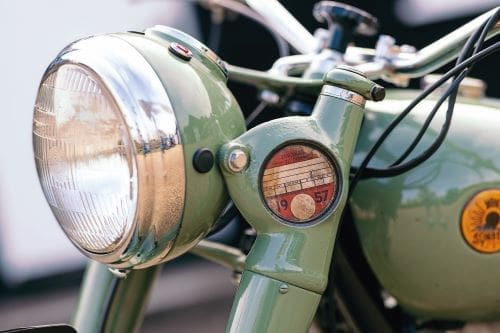
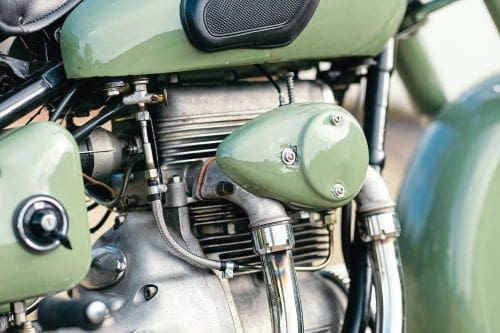
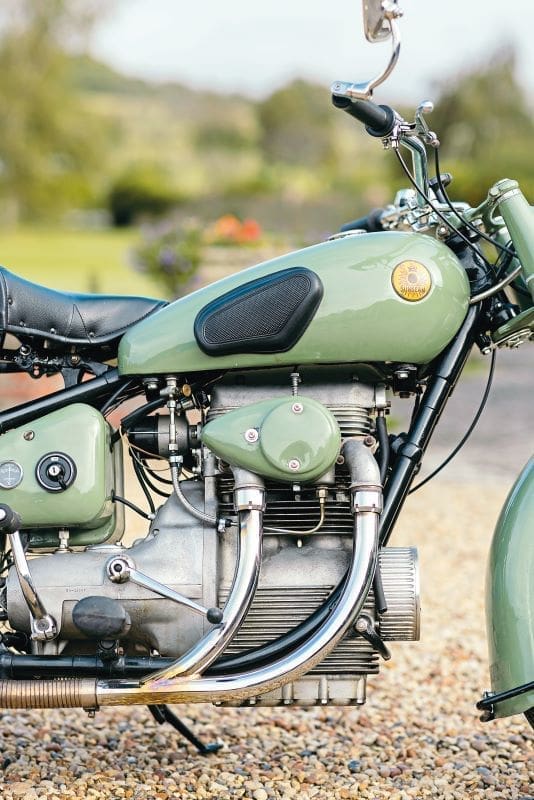
The torque reaction problem had already been effectively tackled by tilting the engine three degrees backwards in the Reynolds 531 duplex cradle frame. Now the handling was transformed by ditching Poppe’s fork and adopting a suitably shrouded version of Val Page’s telescopic design for BSA. The front tyre had also already been changed from the original block pattern to a 4.50×16 ribbed one.
These changes were necessarily incremental rather than fundamental, as so much had already been spent on the tooling for the original, completely unique machine. The result, though, was a real increase in reliability. With its one-piece Mehanite iron crankshaft, the alloy con rods and big end bearing shells, and that superior chrome-molybdenum frame, the S7D was now a respectable-handling machine which, if looked after properly, could and did see 100,000-plus mileages without major attention or a rebore.
With a couple of provisos: the correct oil (currently Morris AG140) had to be used in the worm-drive housing, and changed every 1000 miles; if this was done, despite the worm-drive’s continuing poor reputation, it was actually the Lay-rub joint which would let go, if worn examples were thrashed. For that was the second condition: this motorcycle had to be driven appropriately i.e. sedately, accepting moderate acceleration, and limiting regular top speed to around 60mph – disappointing for an ohc 500. This performance limitation was why, unlike Ariel’s 1000cc Square Four, the S7D never became the hoped-for flagship, for though the Squariel was also heavy and expensive, it accelerated like a good ’un, with a top speed of over 100mph.
The S7D’s fortunes were not helped by the nearly simultaneous release of the S8 variant. With the same engine but a conventional front end, saddle, brakes, wheels and tyres, it was a claimed 35lb lighter and 10mph faster – and at £246, £35 cheaper than the S7D (though a 1952 BSA A7 500cc twin was still £24 less than an S8). In consequence, S8s outsold S7Ds roughly three to two, with 8550 produced, against 5554 S7Ds. But neither were impressive figures by BSA standards, and production quietly ceased at the end of 1955; though examples of new S7Ds could still be found on sale in showrooms as late as 1958 – yesterday’s gentlemen.
Epiphany
I was not expecting much from my S7 De Luxe ride. In the early 1980s, I had tested one belonging to a skilled motorbike mechanic friend, so well fettled, completely original and with just 16,000 miles on the clock. But the originality had extended to the 25-year-old Dunlop tyres (in those pre-Cruiser days, no replacements had been readily available). The handling from the hardened rubber had been off-puttingly memorable, and the performance underwhelming.
David had had some trouble earlier kick-starting the engine again after he’d warmed it up. But by the time I tried it was cooler, and with the standard 6.5:1 compression, originally dictated by the low octane Pool fuel of the 1940s and 1950s, it only took a few prods; lucky, as booting it over-harshly, Andy Chapman would tell me later, can eventually shear the teeth off the bronze kick-start quadrant. A gentle prod or three should do the trick.
From the start, the engine spat intermittently with a slight misfire, nothing chronic but enough to make me keep the revs up for fear of stalling. The car-type single plate clutch was smooth and the gearchange from the bolted-on box, something Poppe had got right, was clean.
Almost immediately, pleasant surprises commenced. The engine felt taut without being tight, and pulled away cleanly and smoothly. The eight-inch brakes, with the front one the stronger, proved to work excellently, at low and medium speeds anyway; this contributed to confidence. On the move, there was no sense of the bike’s weight. Comfort, from the generous pan saddle, unique to the S7D with its sprung wishbone mounting, was good on the sometimes potholed backroads; though since it was adjustable for a rider’s weight, and I tipped the scales at just a bit more than lean David, perhaps it could have been even better. The compensation was the rubber-mounted engine’s smoothness.
But as we hit the road, threading through the village, along a straight, and then another convoluted village, the big revelation was the handling and roadholding through the twists and turns. The modern compound 5.00x16in Avon SM Mk.II tyres, aimed at the likes of Harleys, stuck like glue, and the Sunbeam could be tilted into any bend, however tight, with complete confidence. Incidentally, Andy would tell me later that the Avons need to be kept up to pressure to deliver as they did.
As we left the second village and accelerated away, I could barely believe that this ‘Beam was on sidecar gearing; though as Andy would point out, as such it would pull better at lower speeds, though probably revving higher. But as I realised how well the S7D handled, how effective the brakes were, how willing the engine, how clean the transmission and how smooth the ride, a big grin began to spread. Yes, the Sunbeam was a ‘mouth-expander’, in a good way! I could remember very few test bikes – a particular AJS 500cc twin, world traveller Jackie Furneaux’s 500cc Bullet – which I had enjoyed riding so much.
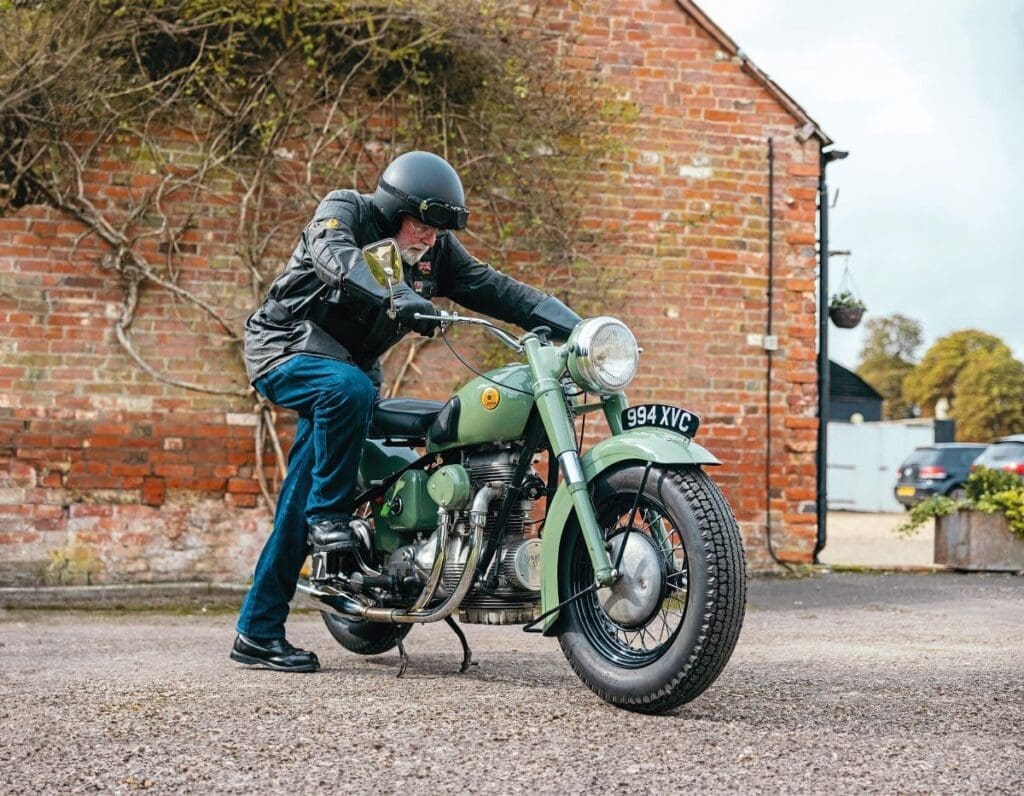
The performance question remained, what VMCC founder Titch Allen had harshly dismissed on his own example as “no guts.” As we burst out onto the straight road running along the base of the Downs, I eased the throttle on, the speed rising from 50 to 55; but mechanical sympathy (yes, I do have some) prevented pushing on to the 60mph of which the S7D on solo gearing would have been well capable. In the rural B-road context, these speeds were fine, and I was having too good a time to crave more. If your hooligan element outweighs the gentlemanly, this is not the bike for you.
At the bottom of the hill, I swung through a 90 degree left-hander, up a sharply steepening road towards the top of the Downs, and the S7D romped up it in top, in another demonstration that soft doesn’t mean incapable. Andy’s first engine rebuild had really delivered. On the down-slope, the brakes proved themselves again.
After a few more miles, however, the spitting misfire was getting no better. It was almost certainly due to the worn original carburettor; there was also a slight momentary impediment in the throttle cable, perhaps due to the float sticking. Later we found some drops of oil leaking from the front dynamo cover, probably due to my keeping the revs up while wheeling about for the camera, since David found it didn’t recur the following day. So it was time to turn for home. But the grin remained pasted in place.
Conclusion
The S7 De Luxe is not for the speed merchant, the ham-fisted or the tight-fisted. It is a British Cruiser and looks the part, with its balloon tyres, shielded carburettor, curvaceous three-gallon tank and generous ‘fenders’ with bobbed rear lip, fairly wide bars, and slash-cut silencer tailpipe. But with a sympathetic keeper in tune with its strengths and weaknesses, it could be a delightful way to get over the ground, with bike and rider looking, and feeling, gentlemanly.
Advert
 Enjoy more The Classic MotorCycle reading in the monthly magazine. Click here to subscribe.
Enjoy more The Classic MotorCycle reading in the monthly magazine. Click here to subscribe.


